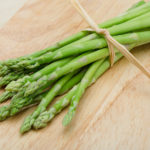 Asparagus, the Elegant Vegetable
Asparagus, the Elegant Vegetable
I grew up eating asparagus out of a can, baked in the oven with slices of melted Swiss cheese across the top…needless to say, my mother was not a nutritionist, nor a lover of vegetables.
As an adult, I was reintroduced to asparagus, this time, the garden-fresh variety which was lightly prepared and placed, ever so elegantly—and linearly—alongside some of the fancy entrees I ordered in restaurants. Oh, I mused, THIS is what asparagus is supposed to look and taste like!
So, what’s so great about asparagus—besides its delicious favor? Well, for starters, it’s low in calories, high in soluble and insoluble fiber, and very high in vitamin K which helps to clot our blood and enrich our bones. Add to this a plethora of antioxidants (vitamins A, B9 (folate), C, E) and a variety of health-promoting flavonoids and you hold a powerful stalk of nourishment in your hands!
The first key to preparing this elegant vegetable at home is to know how to pick out a fresh bunch in the market. Asparagus should be bright green or purple tinged* and its “budded” end should be tightly closed. The cut ends should not appear dried out and the stalks should be firm, not droopy. (If you squeeze a bunch, the stalks should actually “squeak” against each other!)
Once you bring home a healthy bunch, treat it this way: Place the ends in a broad mouthed Ball canning jar, fill with ½ inch of water and place the clear veggie bag over the top of it to create a terrarium-like environment. Or, just fill the veggie bag with a bit of water, stand the stalks up in it and close the top of the bag. Trust me, all this coddling will be worth it!
When readying these stalks for cooking, you must do one final thing: break off the tough lower end. This is best done by holding the stalk with a pincer grip in its midsection and at its end. Bend the stalk until it “snaps”. It will always snap between the tender portion and the part that’s too fibrous to chew easily.
Beyond its elegance on the plate, asparagus is a very delicate vegetable. So, take care not to over cook it or to over season it.
Here are my two favorite ways to prepare asparagus:
- Toss prepared stalks in extra virgin olive oil, S&P and lie them side by side on a baking sheet (cover with aluminum foil for easy clean up). Roast in the oven at 400°F for between 40-55 minutes, depending on the thickness of the stalk. The tips should appear browned, not burnt.
- Cut in 1 ½ inch pieces and drop into boiling water for between 3-5 minutes. They should be fork tender, yet still have a bit of a firmness to them. Toss in a mixture of fresh lemon juice (1/3), EVOO (2/3), S&P. Add in cooked shrimp, or microgreens/bok choy/butter lettuce for a refreshing salad.
*There are white and dark purple varieties as well. The white stalks are grown in the dark so they lack some of the good nutrients. The purple variety has less fiber than the green.